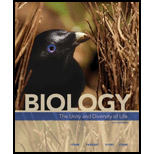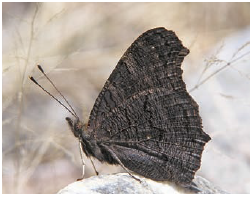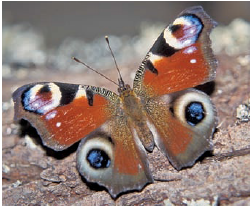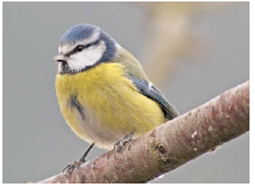
Peacock Butterfly Predator Defenses The photographs below represent the experimental and control groups used in the peacock butterfly experiment discussed in Section 1.6. See if you can identify the experimental groups and match them up with the relevant control group(s). Hint: Identify which variable is being tested in each group (each variable has a control).

A Wing spots painted out

B Wing spots visible; wings silenced

C Wing spots painted out; wings silenced

D Wings painted but spots visible

E Wings cut but not silenced

F Wings painted, spots visible; wings cut, not silenced
Peacock butterfly experiment

A With wings folded, a peacock butterfly resembles a dead leaf, so it is appropriately camouflaged from predatory birds.

B When a predatory bird approaches, a butterfly flicks its wings open and closed, revealing brilliant spots and producing hissing and clicking sounds.

C Researchers tested whether the wing-flicking and sound-making behaviors of peacock butterflies affected predation by blue tits (a type of songbird).
| Experimental Treatment | Number of Butterflies Eaten |
| Wing spots concealed | 5 of 10 (50%) |
| Wings silenced | 0 of 8 (0%) |
| Wing spots painted out and wings silenced | 8 of 10 (80%) |
| No treatment | 0 of 9 (0%) |
*Proceedings of the Royal Society of London, Series B (2005) 272: 1203–1207.
D The researchers painted out the spots of some butterflies, cut the soundmaking part of the wings on others, and did both to a third group; then exposed each butterfly to a hungry blue tit for 30 minutes. Results support only the hypothesis that peacock butterfly spots deter predatory birds.
FIGURE 1.12 Testing the defensive value of two peacock butterfly behaviors.
To match: The experimental groups with their relevant control groups.
Answer to Problem 1DAA
Correct answer:
|
Experimental group |
Control group |
| A | D |
| B | E |
| C | F |
Explanation of Solution
The peacock butterfly predator defense experiment is a controlled experiment because it has both experimental and control groups.
The following are the groups that were studied:
Group A: Wing spots painted out
Group B: Wing spots visible and wings silenced
Group C: Wing spots painted out and wings silenced
Group D: Wings painted but spots visible
Group E: Wings cut but not silenced.
Group F: Wings painted, spots visible, wings cut, and not silenced
- Group A is an experimental group that has the wings painted, and nothing is mentioned about the noise produced by the wing. Group D has the wings painted, but the spots are visible, and nothing is mentioned about the noise produced by the wing. The wing is the independent variable, and the noise is the dependent variable. Therefore, Group D is the control group for experimental Group A.
- Group B is an experimental group that has the wing spots visible, but the noise produced by the wing is silenced. Group E has the wings cut, and the noise produced by the wing is silenced. The wing is the dependent variable, and the noise from the wing is the independent variable. Therefore, Group E is the control group for experimental Group B.
- Group C is an experimental group that has the wing painted, but the spots are visible, and the wings are silenced. Group F has the wings painted, spots visible, and cut, and the noise produced by the wing is not silenced. The wing spot is the dependent variable, and the noise from the wing is the independent variable. Therefore, Group F is the control group for experimental Group C.
Want to see more full solutions like this?
Chapter 1 Solutions
Biology: The Unity and Diversity of Life (MindTap Course List)
Additional Science Textbook Solutions
Human Anatomy & Physiology (11th Edition)
Campbell Essential Biology with Physiology (6th Edition)
Biological Science
Essentials of Human Anatomy & Physiology (12th Edition)
Human Physiology: An Integrated Approach (7th Edition)
- TRUE or FALSE: I expect for genetically identical animals thta have been reared in similar conditions to have a similar SD for any paraeter that I decide to measure compared to genetically diverse animals that have been grown in a variety of natural environments.arrow_forwarda. What are the advantages and disadvantages of using subjective and objective indices of maturity determination? c. Insects, weeds, and pathogens have evolved resistance to chemicals and insects to transgenic Bt crop traits. Describe two specific pest control strategies other than chemical control and the transgenic Bt crops that a farmer who grows grain crops such as corn and rice could employ to control insects, weeds and diseases. Explain how and why IPM, IWM or "many little hammers" can reduce the risk of the pests evolving resistance.arrow_forwardHardy Weinberg Equilibrium In 1975, in a population of 88 garter snakes on the coast of Oregon, 54 of them exhibit the recessive genotype are therefore not immune to the rough-skinned newt’s toxin. Solve for q: Solve for p:arrow_forward
- Ideally, an experimental group differs from a control group (a) only with respect to the hypothesis being tested (b) because its subjects are more reliable (c) in that it is less subject to bias (d) in that it is less vulnerable to sampling error (e) only with respect to the variable being studiedarrow_forwardFrom the diagram: 1. Is A responding variable? 2. Is B manipulated variable? 3. Is C controlled variable OR constant? * This diagram all I'm given for this question; there is no clarifications on what A,B,C are pointing to...arrow_forward5) You want to know if an octopus (octopi are very intelligent!) can tell the difference between circles and rectangles. You provide each octopus with one circular disk and one flattened rectangle. You hide food under the rectangle. After several trials, you then count how many times the octopus picks up the circle and how many times it picks up the rectangle. You get the following results: Circles: 11. Rectangles: 29 Can the octopus tell the difference between circles and rectangles? (Hint: if the octopus can't tell the difference, what's the probability that he/she will pick a circle?arrow_forward
- I expect for genetically identical animals that have been reared in similar conditions to have a smaller SD for any parameter that I decide to measure compared to genetically diverse animals that have been grown in a variety of natural environments. A-TrueB-Falsearrow_forwardWhat is your analysis in the What is your analysis on the given picture? How is this concept important?arrow_forwardYou set up an RNAi experiment in worms and you use adult worms instead of L4 worms. How might this affect the observed efficiency of RNAi ( meaning the number of offspring with observable phenotype) for this experiment when counting the progeny? the efficiency will appear lower No observable difference between using L4 or adults. RNAi will not work using adult worms. the efficiency will be higherarrow_forward
- What is the primary reason for randomizing group allocation in a randomized controlled trial (RCT)? Question 3 options: to create treatment and control groups of equal size to blind participants to their group allocation to evenly distribute known and unknown factors that may affect the outcome between groups to increase the treatment effect between intervention and control groupsarrow_forwardI am trying to figure out these four things. What is the independent variable, what is the dependent variable, what are the controlled variables and why this experiment doesn’t use a control.arrow_forward16 In the experiment above measuring the effect of coffee on heart rate, if you had oatmeal some days and cereal other days with your coffee, these other variables would be called: Select one: a. Sample variables b. Random sampling c. None of the above d. Confounding variablesarrow_forward
 Biology: The Unity and Diversity of Life (MindTap...BiologyISBN:9781337408332Author:Cecie Starr, Ralph Taggart, Christine Evers, Lisa StarrPublisher:Cengage Learning
Biology: The Unity and Diversity of Life (MindTap...BiologyISBN:9781337408332Author:Cecie Starr, Ralph Taggart, Christine Evers, Lisa StarrPublisher:Cengage Learning Biology: The Unity and Diversity of Life (MindTap...BiologyISBN:9781305073951Author:Cecie Starr, Ralph Taggart, Christine Evers, Lisa StarrPublisher:Cengage Learning
Biology: The Unity and Diversity of Life (MindTap...BiologyISBN:9781305073951Author:Cecie Starr, Ralph Taggart, Christine Evers, Lisa StarrPublisher:Cengage Learning Biology Today and Tomorrow without Physiology (Mi...BiologyISBN:9781305117396Author:Cecie Starr, Christine Evers, Lisa StarrPublisher:Cengage Learning
Biology Today and Tomorrow without Physiology (Mi...BiologyISBN:9781305117396Author:Cecie Starr, Christine Evers, Lisa StarrPublisher:Cengage Learning Human Heredity: Principles and Issues (MindTap Co...BiologyISBN:9781305251052Author:Michael CummingsPublisher:Cengage Learning
Human Heredity: Principles and Issues (MindTap Co...BiologyISBN:9781305251052Author:Michael CummingsPublisher:Cengage Learning Biology (MindTap Course List)BiologyISBN:9781337392938Author:Eldra Solomon, Charles Martin, Diana W. Martin, Linda R. BergPublisher:Cengage Learning
Biology (MindTap Course List)BiologyISBN:9781337392938Author:Eldra Solomon, Charles Martin, Diana W. Martin, Linda R. BergPublisher:Cengage Learning Biology: The Dynamic Science (MindTap Course List)BiologyISBN:9781305389892Author:Peter J. Russell, Paul E. Hertz, Beverly McMillanPublisher:Cengage Learning
Biology: The Dynamic Science (MindTap Course List)BiologyISBN:9781305389892Author:Peter J. Russell, Paul E. Hertz, Beverly McMillanPublisher:Cengage Learning





